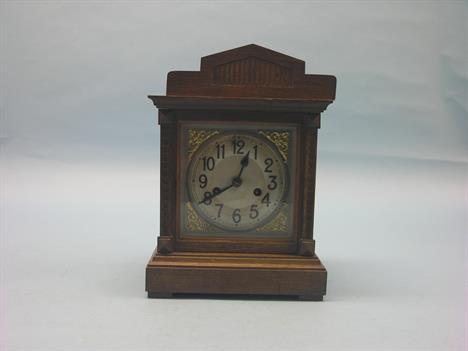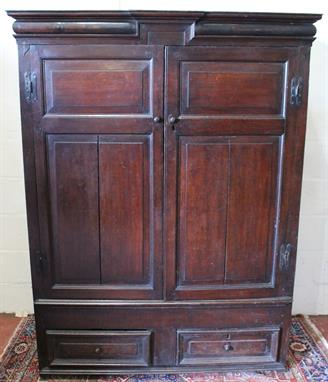P. Caminda, a mahogany stick barometer: the silvered dial engraved with typical gauge, maker`s name P. Caminda, Taunton and set with a thermometer to the side, with a glazed hinged door, the mahogany case with a visible tube, crossbanding to the sides, a turned cistern to the base and an architectural pediment with a turned brass finial to the centre, height: 97cm. * Peter Caminda is recorded as working in the High Street, Taunton from circa 1820 until at least 1845.
We found 35023 price guide item(s) matching your search
There are 35023 lots that match your search criteria. Subscribe now to get instant access to the full price guide service.
Click here to subscribe- List
- Grid
-
35023 item(s)/page
Donaldson, T.L. ARCHITECTURA NUMISMATICA; OR, ARCHITECTURAL MEDALS OF CLASSIC ANTIQUITY: ILLUSTRATED AND EXPLAINED BY COMPARISON WITH THE MONUMENTS AND THE DESCRIPTIONS OF THE ANCIENT AUTHORS, AND COPIOUS TEXT. London: Day & Son, 1859. Crown 4to, later blue cloth, gilt. xxxi, (1), 349, (3) pages; 100 attractive lithographs and woodcuts, mostly depicting coins. Near fine. A fundamental work. Rather scarce. Clain-Stefanelli 4755*. Ex David Bullowa, with his blind stamp; apparently ex Charles E. Lawrence, with his bookplate laid in.
[Pisani and Corraro]. (Mazzoleni, Alberto). IN NUMISMATA ÆREA SELECTIORA MAXIMI MODULI E MUSEO PISANO OLIM CORRARIO. In Monasterio Benedictino-Casinate: S. Jacobi Pontidæ Agri Bergomatis, Apud Joannem Santinum Sumptibus Societatis, 1740 / Venetiis: Apud Jo. Baptistam Albritium, undated. Two volumes. I: (10), 244 pages; title printed in red and black; finely engraved large title engraving of both sides of a Roman medallion, surmounted by two putti; finely engraved and woodcut initials, headpieces and tailpieces. II: 96 leaves, comprising a superbly engraved allegorical architectural frontispiece featuring the arms of Correr and Pisani, respectively supported by two dragons and two lions; title within a handsomely engraved border; finely engraved preface; finely engraved index; 92 finely engraved numbered plates of ancient Roman coins, generally depicting both sides of three coins within elaborately engraved cartouches, each different and often featuring putti, animals and other decorative devices. Large folio [45 by 32 cm], complementary though not matching modern brown leather and marbled boards, gilt. Fine. A monumental production, combining a volume of detailed coin descriptions with this superb series of plates depicting ancient Roman coins within delightful baroque cartouches. Rarely offered complete. Published for the first time in 1740–41, the plates illustrate the fine collection formed by Girolamo Corraro and his son Angelo (Pope Gregory XII, 1406–15), and later completed by Ermolao Pisani. Ex Ferdinando Bassoli (Kolbe Sale 108, lot 206), with his bookplate.; ex June 3, 2006 Kolbe sale, lot 76. Babelon pages 113–114. Hennin 224 and 2922. Lipsius 315. Strandberg 114.
Paciaudi, Paolo M. AD NUMMOS CONSULARES IIIVIRI [TRIUMVIRI] MARCI ANTONII. ANIMADVERSIONES PHILOLOGICAE ACCEDIT EXPLICATIO TABULAE PELOPONNENSIS. Romae: Excudebant Fratres Palearini, Publica Auctoritate, 1757. 4to [28 by 21 cm], contemporary card covers. 126, (2) pages; title printed in red and black with a delightful, finely engraved architectural numismatic vignette; finely engraved historiated headpiece and tailpiece; woodcut tailpieces; fine engravings in the text of ancient coins and two historical scenes; one full page of ancient coin engravings; woodcut printer’s device. Occasional minor spotting. Fine. Ex Richetto, 2004. Ex Ferdinando Bassoli, with his bookplate. Paolo Maria Paciaudi of Turin (1710–81), was a Theatine priest and a well-known authority on numismatics and ecclesiastical archeology. His Philological Observations appears to be quite rare. Correspondence, mainly on antiquarian topics, between Paciaudi and the French writer and noted numismatist, Jean Jacques Barthelemy (1716–95), may be found in the 1877 Correspondance indite du Comte de Caylus by Ch. Nisard. Lipsius 302.
Two 19th Century bound volumes to include an album marked Germany 1882 filled with mounted sketches, watercolours and photographs from a tour, various hands, including portraits, architectural and landscape views, and Fifty portraits of Eminent Personages by D.J Pound (active 1842-1877) of various gentleman and ladies from the 19th Century to include the Prince Consort and Queen Victoria, some with fascimile signatures, printing error to back, Empress Eugenie bound at an angle and one gentleman appearing twice.
JOHN HARDMAN & CO. STUDIO. Two unframed, watercolours on paper, stained glass window designs; one 1920`s Gothic Architectural framework with four lights and twenty three traceries, `St. Joseph`, `Our Lady and Child Jesus`, `St Anne` and `St. Joachim` and a mounted, 1932, with two lights, `Christ with St. Peter` and cinquefoil tracery bearing Papel coat of arms, with John Hardman lozenge. (2) 54cm x 33cm and 48.5cm x 22.5cm.
JOHN HARDMAN & CO. STUDIO. Three unframed, pen, ink and watercolours on paper, 19th Century brass designs; one inscribed, `No. 3`, rectangular architectural brass `Christ saving St. Peter from drowning` beneath Gothic architecture, embellished with two shields, one inscribed, `No.2`, a memorial inscription embellished with Gothic architecture, two angels supporting shield, with two other shields above, and a fleur de lis cross bearing emblems of four `Evangelists`, `Agnes Dei`, the letter `B`, with coat of arms and inscription Gothic Architecture base all encased in a rectangular patterned border. (3) 38cm x 19.5cm, 40cm x 23cm and 38.5cm x 26.5cm.
Orlando Norie (1832 -1901) ``5th Princess Charlotte of Wales`s Dragoon Guards`` signed, watercolour, together with a collection of equestrian watercolours on silk, prints after Henry Alken, architectural engravings and engraved maps of Somersetshire & ``Environs of Bath and Bristol`` (qty) 14.5cm by 14cm & various other sizes
Diego GIACOMETTI (1902-1985) Exceptionnelle applique à cinq lumières en bronze à patine dorée à décor de panthères H : 31 cm - L : 55 cm Cette applique se trouvait au domicile de Diego GIACOMETTI rue du Moulin Vert à Paris. Elle est l`un des deux seuls tirages connus du plâtre original qui fait partie de la donation Giacometti au musée des Arts Décoratifs (1986). Le second tirage de cette applique se trouve depuis le décès de l`artiste dans une collection privée à Genève. Certificat d`authenticité de M. Denis VINCENOT Bibliographie : Michel BUTOR “Diego GIACOMETTI” par Adrien MAEGHT éditeur 1985 p. 49 Revue “Architectural Digest” Août 1983
Quantity of fine bindings, including Tennyson, Kingsley, Priestley, "Veterinary Journal", vol. 18-19, Hartwig "Harmonies of Nature", Macgregor, Robertson "Household Physician", works on and by Livingstone, various ledgers, and from the Eiffel.C.S. Reference Library "Architectural and Perspective Drawing, Sketching and Measuring Shades and Shadows", and various other volumes (2 boxes)
A William Clement (c.1670) ebony longcase clock, having an architectural hood (formally rising) enclosing a 10" square brass dial signed below chapter ring 'Wm Clement Londini Fecit', with further cast gilt brass cherub mask spandrels dispersed with foliate engraving, the silvered chapter ring with Roman numerals enclosing matted centre, pierced steel single hand, twin winding holes for an eight day duration five latched and ringed pillar weight driven movement, with Royal 1¼ second two-piece latch and pillar pendulum, brass cased weights and striking on a bell, the case with three panelled door within ogee mouldings, the boxbase with concealed hinge door for pendulum regulation, later plinth, case h.206cm (81") The whole with restoration - a condition report is available upon request. Footnote: William Clement (circa 1638/39-circa 1709) is recognised as one of the most innovative clockmakers of his time. He is widely co-credited for inventing the anchor escapement and was also possibly the first person to use a spring-suspended pendulum. Little is known about his early history, but he was apprenticed in the Blacksmiths' Company in 1657 and a Freeman of the Clockmakers' Company from 1677. He was rapidly made an Assistant in the Company 'by unanimous consent and approbation and for good reason and especial esteem' in 1678, and in 1694 he became Master.
Danish settee, designer unknown, imported by Raymor, architectural teak frame with elongated cross-stretchers, sage green silk upholstery, original finish, signed with "Created in Denmark for Raymor" tag, 48"w x 28"d x 32"h, very good original condition No chips or cracks. No repairs. Sturdy and structurally sound. A round decal is missing–it was likely a Danish Furniture Control tag. A few light stains to the fabric. The seat sags a little; the straps under the seat are intact but are dry and sagging.
Frank Lloyd Wright single-drawer desk, for the Imperial Hotel, Tokyo, Japan, c. 1916-1922, rectangular top, notched corner, molded Greek-key frieze, shallow drawer with brass pull, refinished, 26"w x 28"d x 28"h, very good condition Provenance: Christie`s, New York, New York, Arts & Crafts and Architectural Designs, Sale 7586, Lot 169, 12 December 1992 re-coated original finish, some brackets added, structurally sound
Charles Atwood designed architectural fragment from the Fisher Building in Chicago, D.H. Burnham & Co. architects, cast by Winslow Brothers foundry, 1895-96, figural elevator floor indicator depicting opposing stylized dolphins centered by a shell, 21.5"w x 24.5"h, very good condition Catalogue note: The Fisher building is listed on the National Register of Historic Places and designated as a Chicago Landmark good original finish
Dankmar Adler & Louis Sullivan architectural block, from the Chicago Stock Exchange Building, c. 1893, organic design in unglazed terracotta, with display base, 24"w x 20"d x 10"h, very good condition with usual wear Catalogue note: The Chicago Stock Exchange was demolished in 1972 some old surface chips and minor losses visible in photo
-
35023 item(s)/page















![[Pisani and Corraro]. (Mazzoleni, Alberto). IN NUMISMATA ÆREA SELECTIORA MAXIMI MODULI E MUSEO PISANO OLIM CORRARIO. In Monas](http://lot-images.atgmedia.com/SR/35818/2891609/1379-20131213162257_468x382.jpg)
![Paciaudi, Paolo M. AD NUMMOS CONSULARES IIIVIRI [TRIUMVIRI] MARCI ANTONII. ANIMADVERSIONES PHILOLOGICAE ACCEDIT EXPLICATIO TA](http://lot-images.atgmedia.com/SR/35818/2891609/1398-20131213162451_468x382.jpg)








































